Macroeconomics: Monetary Policy in Indonesia Report
VerifiedAdded on 2022/08/25
|6
|1132
|20
Report
AI Summary
This report analyzes the potential easing of monetary policy in Indonesia, as discussed in a Bloomberg article. The analysis employs the aggregate demand-aggregate supply (AD-AS) model to assess the impact of monetary policy on the Indonesian economy, considering factors such as interest rates, money supply, and their effects on investment, production, employment, and price levels. The report examines the economic slowdown, the government's reliance on Bank Indonesia's monetary policy, and the potential effects of interest rate reductions on investment, aggregate supply and demand, and overall economic growth. The author concludes that while monetary easing can boost output, it may not improve price levels and suggests expansionary fiscal policy to boost aggregate demand and price levels. The report includes graphical illustrations of the money market and the effects of monetary policy easing, along with references to relevant macroeconomic theories.
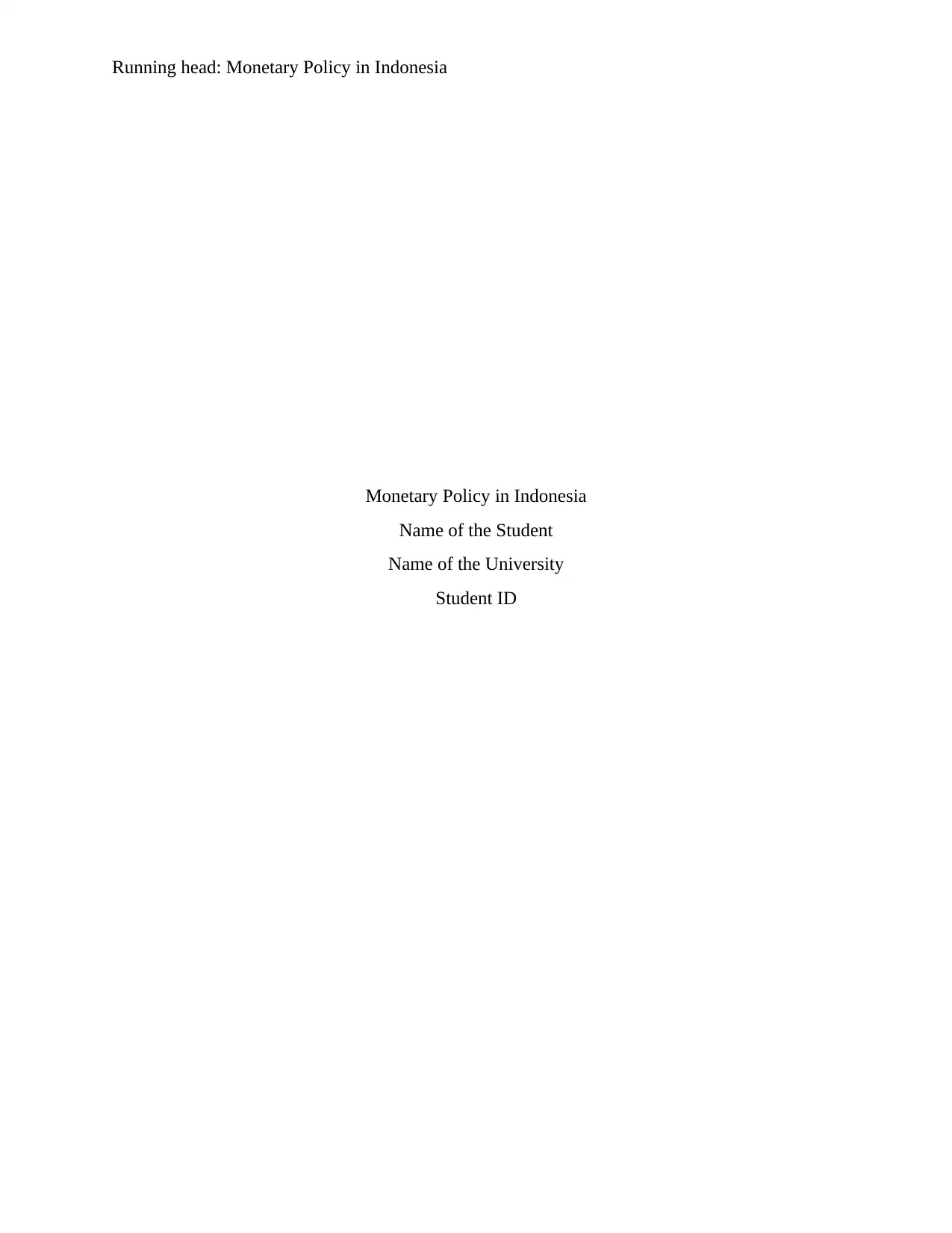
Running head: Monetary Policy in Indonesia
Monetary Policy in Indonesia
Name of the Student
Name of the University
Student ID
Monetary Policy in Indonesia
Name of the Student
Name of the University
Student ID
Paraphrase This Document
Need a fresh take? Get an instant paraphrase of this document with our AI Paraphraser
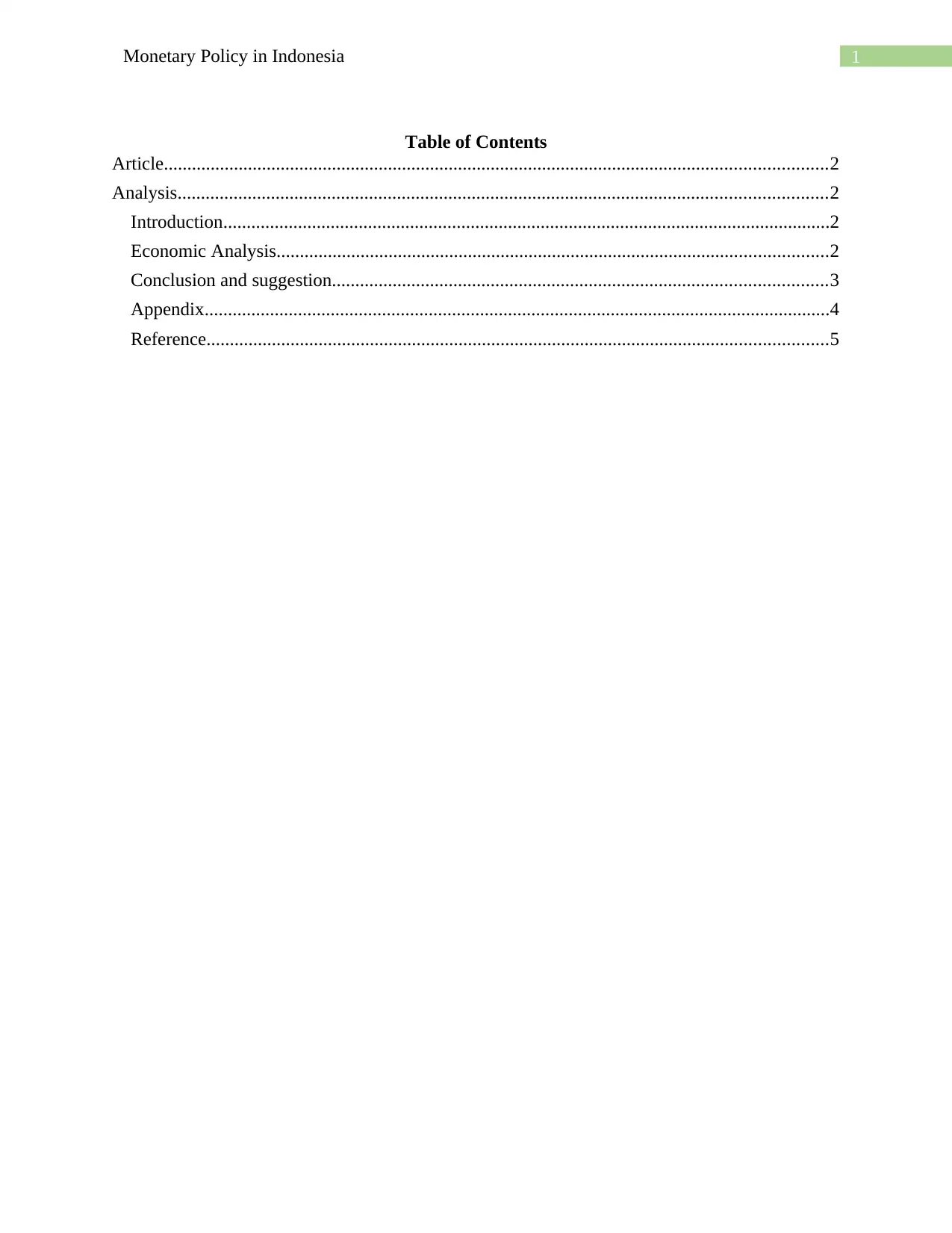
1Monetary Policy in Indonesia
Table of Contents
Article..............................................................................................................................................2
Analysis...........................................................................................................................................2
Introduction..................................................................................................................................2
Economic Analysis......................................................................................................................2
Conclusion and suggestion..........................................................................................................3
Appendix......................................................................................................................................4
Reference.....................................................................................................................................5
Table of Contents
Article..............................................................................................................................................2
Analysis...........................................................................................................................................2
Introduction..................................................................................................................................2
Economic Analysis......................................................................................................................2
Conclusion and suggestion..........................................................................................................3
Appendix......................................................................................................................................4
Reference.....................................................................................................................................5
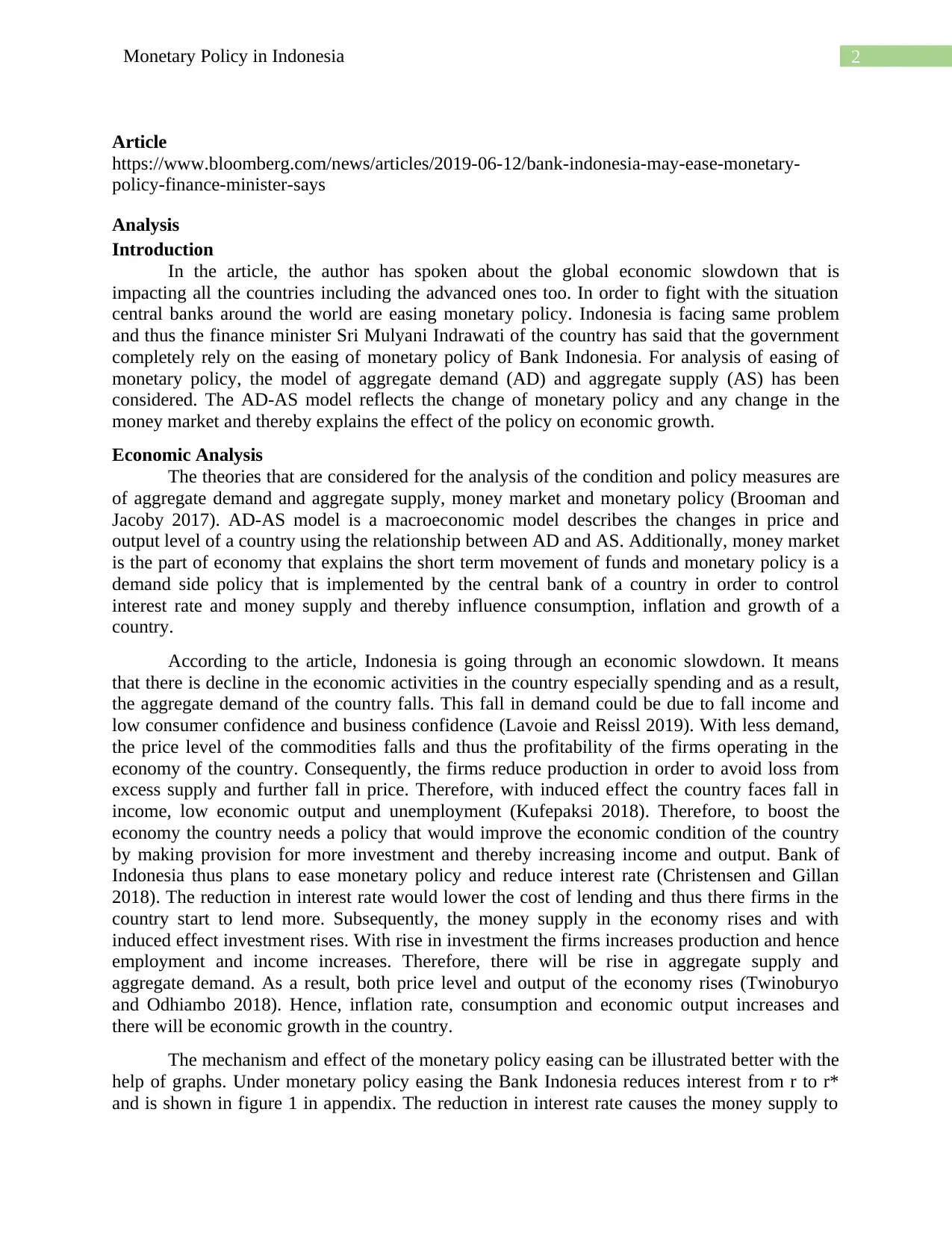
2Monetary Policy in Indonesia
Article
https://www.bloomberg.com/news/articles/2019-06-12/bank-indonesia-may-ease-monetary-
policy-finance-minister-says
Analysis
Introduction
In the article, the author has spoken about the global economic slowdown that is
impacting all the countries including the advanced ones too. In order to fight with the situation
central banks around the world are easing monetary policy. Indonesia is facing same problem
and thus the finance minister Sri Mulyani Indrawati of the country has said that the government
completely rely on the easing of monetary policy of Bank Indonesia. For analysis of easing of
monetary policy, the model of aggregate demand (AD) and aggregate supply (AS) has been
considered. The AD-AS model reflects the change of monetary policy and any change in the
money market and thereby explains the effect of the policy on economic growth.
Economic Analysis
The theories that are considered for the analysis of the condition and policy measures are
of aggregate demand and aggregate supply, money market and monetary policy (Brooman and
Jacoby 2017). AD-AS model is a macroeconomic model describes the changes in price and
output level of a country using the relationship between AD and AS. Additionally, money market
is the part of economy that explains the short term movement of funds and monetary policy is a
demand side policy that is implemented by the central bank of a country in order to control
interest rate and money supply and thereby influence consumption, inflation and growth of a
country.
According to the article, Indonesia is going through an economic slowdown. It means
that there is decline in the economic activities in the country especially spending and as a result,
the aggregate demand of the country falls. This fall in demand could be due to fall income and
low consumer confidence and business confidence (Lavoie and Reissl 2019). With less demand,
the price level of the commodities falls and thus the profitability of the firms operating in the
economy of the country. Consequently, the firms reduce production in order to avoid loss from
excess supply and further fall in price. Therefore, with induced effect the country faces fall in
income, low economic output and unemployment (Kufepaksi 2018). Therefore, to boost the
economy the country needs a policy that would improve the economic condition of the country
by making provision for more investment and thereby increasing income and output. Bank of
Indonesia thus plans to ease monetary policy and reduce interest rate (Christensen and Gillan
2018). The reduction in interest rate would lower the cost of lending and thus there firms in the
country start to lend more. Subsequently, the money supply in the economy rises and with
induced effect investment rises. With rise in investment the firms increases production and hence
employment and income increases. Therefore, there will be rise in aggregate supply and
aggregate demand. As a result, both price level and output of the economy rises (Twinoburyo
and Odhiambo 2018). Hence, inflation rate, consumption and economic output increases and
there will be economic growth in the country.
The mechanism and effect of the monetary policy easing can be illustrated better with the
help of graphs. Under monetary policy easing the Bank Indonesia reduces interest from r to r*
and is shown in figure 1 in appendix. The reduction in interest rate causes the money supply to
Article
https://www.bloomberg.com/news/articles/2019-06-12/bank-indonesia-may-ease-monetary-
policy-finance-minister-says
Analysis
Introduction
In the article, the author has spoken about the global economic slowdown that is
impacting all the countries including the advanced ones too. In order to fight with the situation
central banks around the world are easing monetary policy. Indonesia is facing same problem
and thus the finance minister Sri Mulyani Indrawati of the country has said that the government
completely rely on the easing of monetary policy of Bank Indonesia. For analysis of easing of
monetary policy, the model of aggregate demand (AD) and aggregate supply (AS) has been
considered. The AD-AS model reflects the change of monetary policy and any change in the
money market and thereby explains the effect of the policy on economic growth.
Economic Analysis
The theories that are considered for the analysis of the condition and policy measures are
of aggregate demand and aggregate supply, money market and monetary policy (Brooman and
Jacoby 2017). AD-AS model is a macroeconomic model describes the changes in price and
output level of a country using the relationship between AD and AS. Additionally, money market
is the part of economy that explains the short term movement of funds and monetary policy is a
demand side policy that is implemented by the central bank of a country in order to control
interest rate and money supply and thereby influence consumption, inflation and growth of a
country.
According to the article, Indonesia is going through an economic slowdown. It means
that there is decline in the economic activities in the country especially spending and as a result,
the aggregate demand of the country falls. This fall in demand could be due to fall income and
low consumer confidence and business confidence (Lavoie and Reissl 2019). With less demand,
the price level of the commodities falls and thus the profitability of the firms operating in the
economy of the country. Consequently, the firms reduce production in order to avoid loss from
excess supply and further fall in price. Therefore, with induced effect the country faces fall in
income, low economic output and unemployment (Kufepaksi 2018). Therefore, to boost the
economy the country needs a policy that would improve the economic condition of the country
by making provision for more investment and thereby increasing income and output. Bank of
Indonesia thus plans to ease monetary policy and reduce interest rate (Christensen and Gillan
2018). The reduction in interest rate would lower the cost of lending and thus there firms in the
country start to lend more. Subsequently, the money supply in the economy rises and with
induced effect investment rises. With rise in investment the firms increases production and hence
employment and income increases. Therefore, there will be rise in aggregate supply and
aggregate demand. As a result, both price level and output of the economy rises (Twinoburyo
and Odhiambo 2018). Hence, inflation rate, consumption and economic output increases and
there will be economic growth in the country.
The mechanism and effect of the monetary policy easing can be illustrated better with the
help of graphs. Under monetary policy easing the Bank Indonesia reduces interest from r to r*
and is shown in figure 1 in appendix. The reduction in interest rate causes the money supply to
⊘ This is a preview!⊘
Do you want full access?
Subscribe today to unlock all pages.

Trusted by 1+ million students worldwide
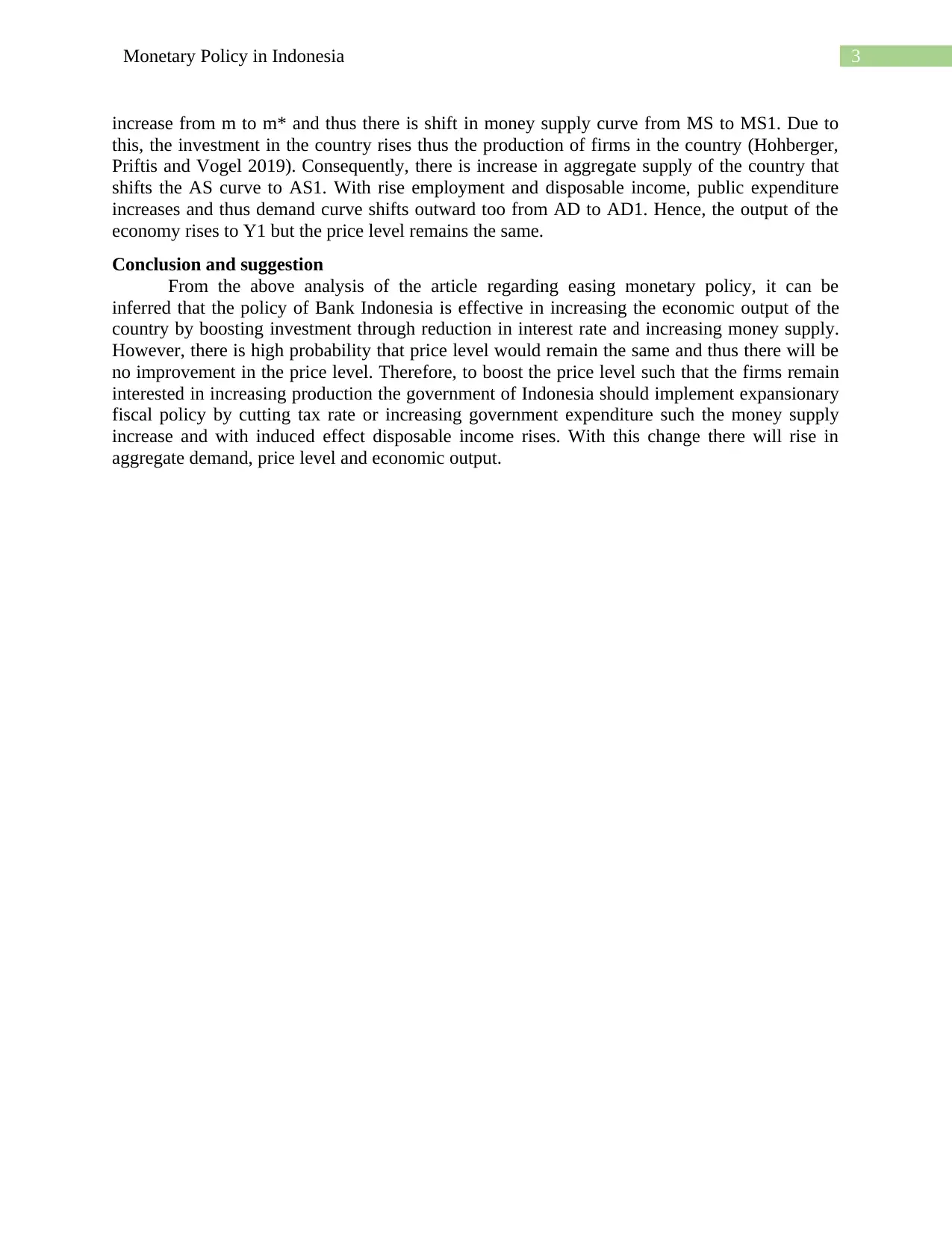
3Monetary Policy in Indonesia
increase from m to m* and thus there is shift in money supply curve from MS to MS1. Due to
this, the investment in the country rises thus the production of firms in the country (Hohberger,
Priftis and Vogel 2019). Consequently, there is increase in aggregate supply of the country that
shifts the AS curve to AS1. With rise employment and disposable income, public expenditure
increases and thus demand curve shifts outward too from AD to AD1. Hence, the output of the
economy rises to Y1 but the price level remains the same.
Conclusion and suggestion
From the above analysis of the article regarding easing monetary policy, it can be
inferred that the policy of Bank Indonesia is effective in increasing the economic output of the
country by boosting investment through reduction in interest rate and increasing money supply.
However, there is high probability that price level would remain the same and thus there will be
no improvement in the price level. Therefore, to boost the price level such that the firms remain
interested in increasing production the government of Indonesia should implement expansionary
fiscal policy by cutting tax rate or increasing government expenditure such the money supply
increase and with induced effect disposable income rises. With this change there will rise in
aggregate demand, price level and economic output.
increase from m to m* and thus there is shift in money supply curve from MS to MS1. Due to
this, the investment in the country rises thus the production of firms in the country (Hohberger,
Priftis and Vogel 2019). Consequently, there is increase in aggregate supply of the country that
shifts the AS curve to AS1. With rise employment and disposable income, public expenditure
increases and thus demand curve shifts outward too from AD to AD1. Hence, the output of the
economy rises to Y1 but the price level remains the same.
Conclusion and suggestion
From the above analysis of the article regarding easing monetary policy, it can be
inferred that the policy of Bank Indonesia is effective in increasing the economic output of the
country by boosting investment through reduction in interest rate and increasing money supply.
However, there is high probability that price level would remain the same and thus there will be
no improvement in the price level. Therefore, to boost the price level such that the firms remain
interested in increasing production the government of Indonesia should implement expansionary
fiscal policy by cutting tax rate or increasing government expenditure such the money supply
increase and with induced effect disposable income rises. With this change there will rise in
aggregate demand, price level and economic output.
Paraphrase This Document
Need a fresh take? Get an instant paraphrase of this document with our AI Paraphraser
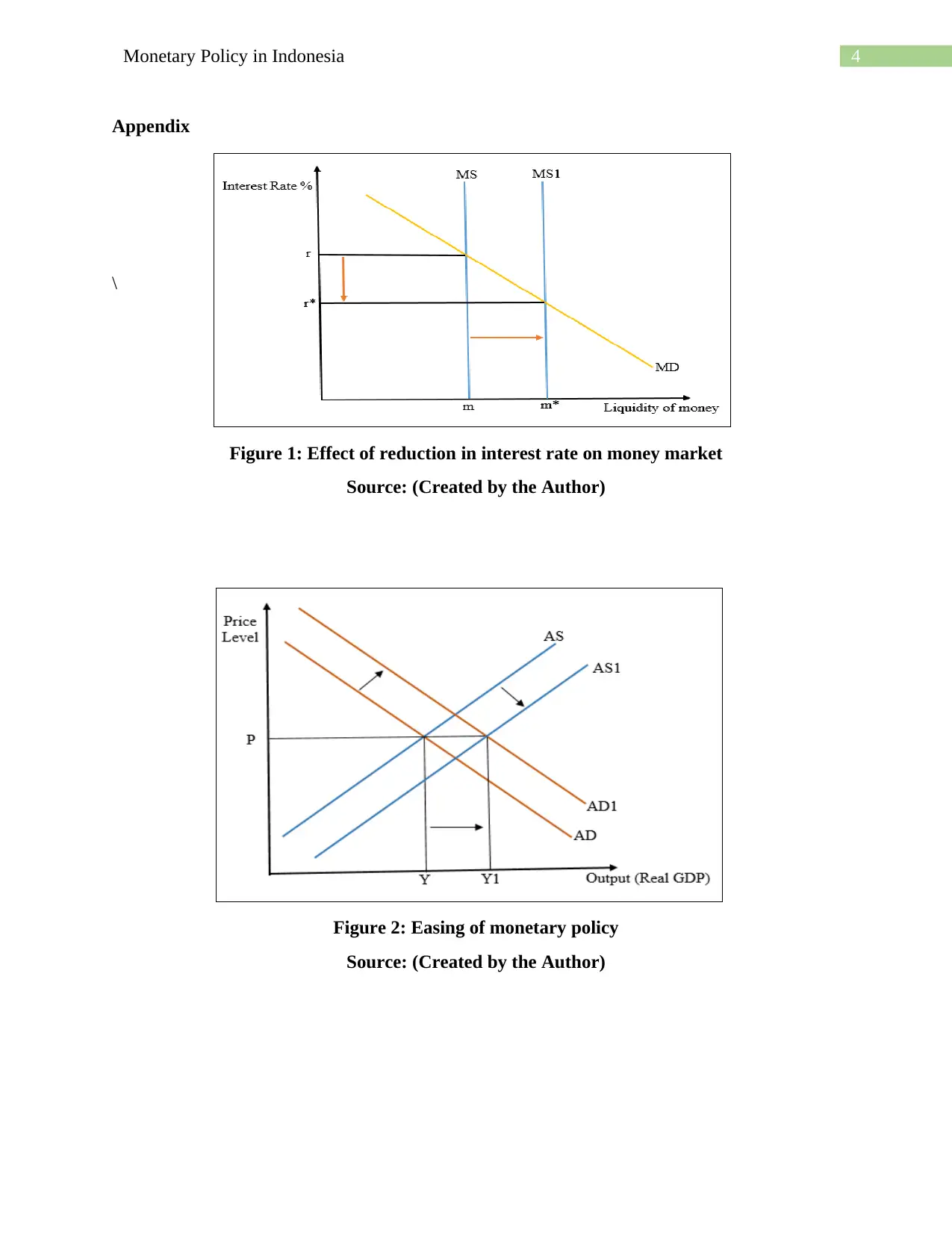
4Monetary Policy in Indonesia
Appendix
\
Figure 1: Effect of reduction in interest rate on money market
Source: (Created by the Author)
Figure 2: Easing of monetary policy
Source: (Created by the Author)
Appendix
\
Figure 1: Effect of reduction in interest rate on money market
Source: (Created by the Author)
Figure 2: Easing of monetary policy
Source: (Created by the Author)
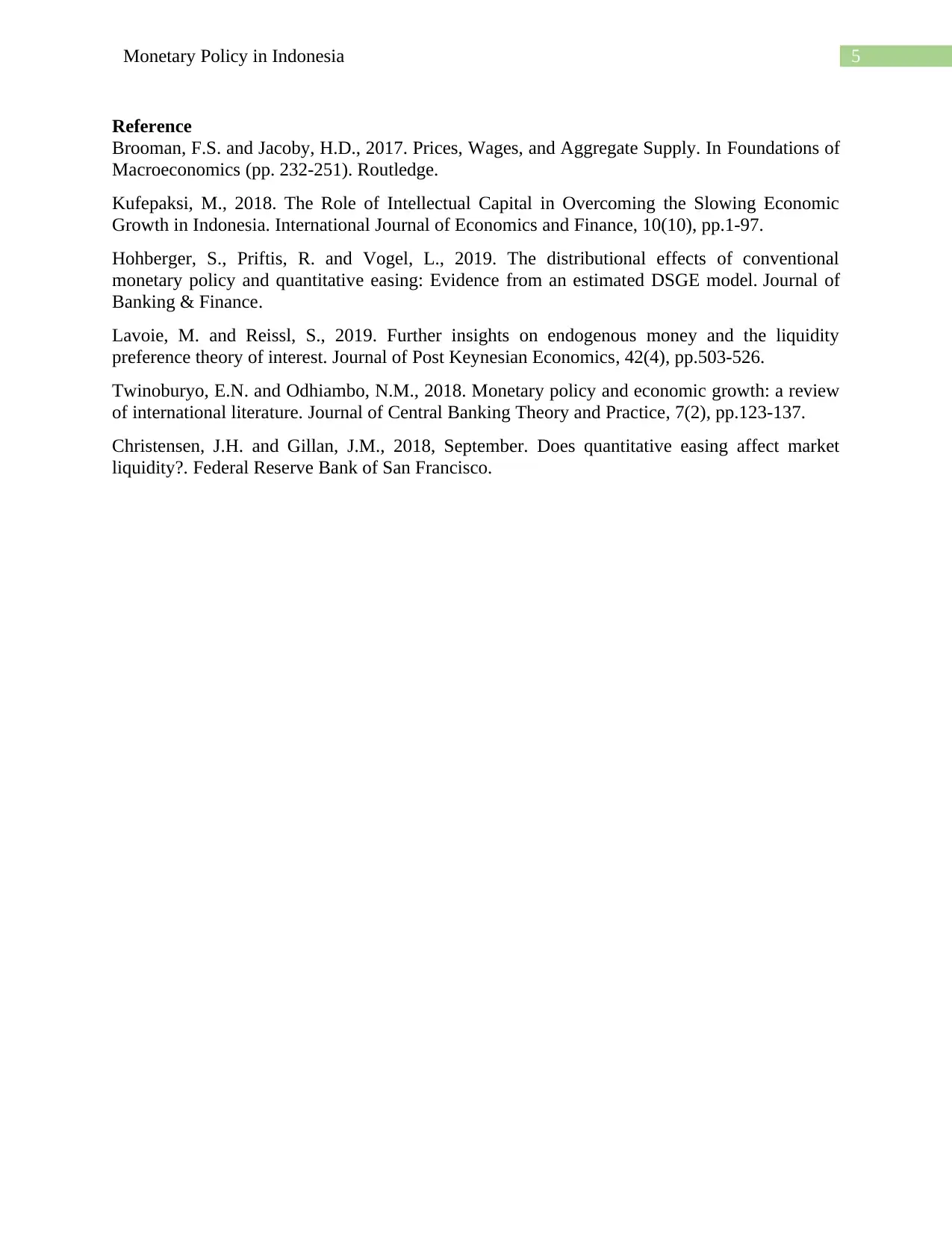
5Monetary Policy in Indonesia
Reference
Brooman, F.S. and Jacoby, H.D., 2017. Prices, Wages, and Aggregate Supply. In Foundations of
Macroeconomics (pp. 232-251). Routledge.
Kufepaksi, M., 2018. The Role of Intellectual Capital in Overcoming the Slowing Economic
Growth in Indonesia. International Journal of Economics and Finance, 10(10), pp.1-97.
Hohberger, S., Priftis, R. and Vogel, L., 2019. The distributional effects of conventional
monetary policy and quantitative easing: Evidence from an estimated DSGE model. Journal of
Banking & Finance.
Lavoie, M. and Reissl, S., 2019. Further insights on endogenous money and the liquidity
preference theory of interest. Journal of Post Keynesian Economics, 42(4), pp.503-526.
Twinoburyo, E.N. and Odhiambo, N.M., 2018. Monetary policy and economic growth: a review
of international literature. Journal of Central Banking Theory and Practice, 7(2), pp.123-137.
Christensen, J.H. and Gillan, J.M., 2018, September. Does quantitative easing affect market
liquidity?. Federal Reserve Bank of San Francisco.
Reference
Brooman, F.S. and Jacoby, H.D., 2017. Prices, Wages, and Aggregate Supply. In Foundations of
Macroeconomics (pp. 232-251). Routledge.
Kufepaksi, M., 2018. The Role of Intellectual Capital in Overcoming the Slowing Economic
Growth in Indonesia. International Journal of Economics and Finance, 10(10), pp.1-97.
Hohberger, S., Priftis, R. and Vogel, L., 2019. The distributional effects of conventional
monetary policy and quantitative easing: Evidence from an estimated DSGE model. Journal of
Banking & Finance.
Lavoie, M. and Reissl, S., 2019. Further insights on endogenous money and the liquidity
preference theory of interest. Journal of Post Keynesian Economics, 42(4), pp.503-526.
Twinoburyo, E.N. and Odhiambo, N.M., 2018. Monetary policy and economic growth: a review
of international literature. Journal of Central Banking Theory and Practice, 7(2), pp.123-137.
Christensen, J.H. and Gillan, J.M., 2018, September. Does quantitative easing affect market
liquidity?. Federal Reserve Bank of San Francisco.
⊘ This is a preview!⊘
Do you want full access?
Subscribe today to unlock all pages.

Trusted by 1+ million students worldwide
1 out of 6
Related Documents
Your All-in-One AI-Powered Toolkit for Academic Success.
+13062052269
info@desklib.com
Available 24*7 on WhatsApp / Email
![[object Object]](/_next/static/media/star-bottom.7253800d.svg)
Unlock your academic potential
Copyright © 2020–2025 A2Z Services. All Rights Reserved. Developed and managed by ZUCOL.


